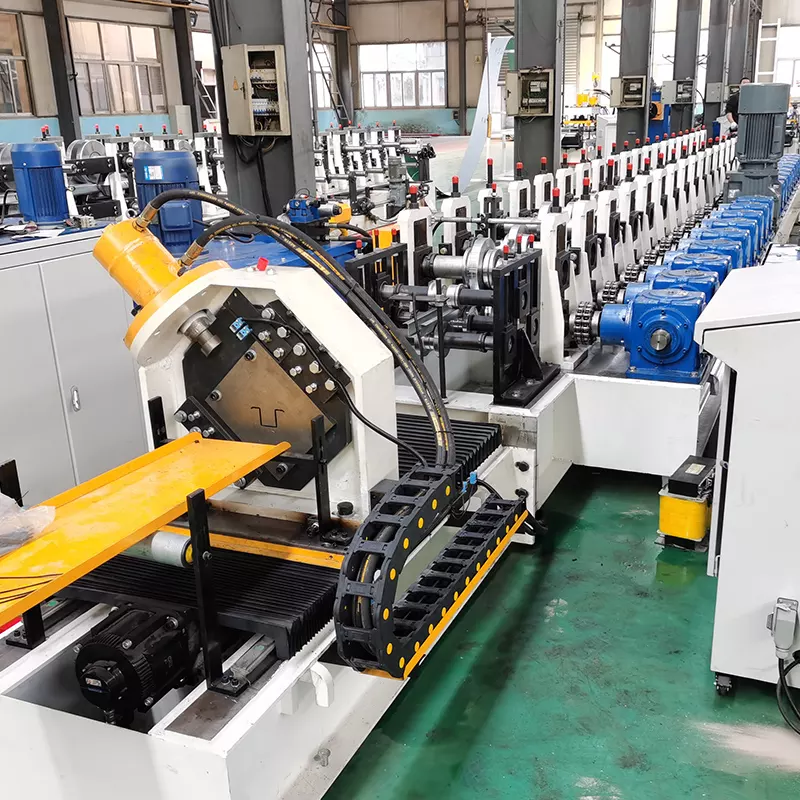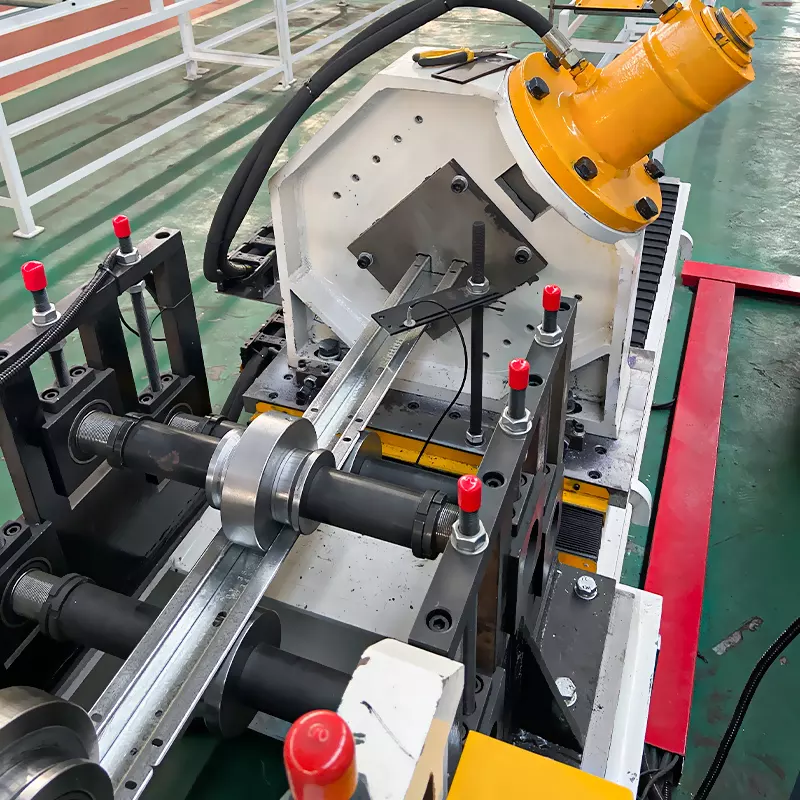Introducción
los bending radius en el perfilado desempeña un papel crucial en determining profile accuracy, material integrity, and overall production efficiency. Selecting the right bending radius ensures rendimiento óptimo del conformado, defectos mínimos y mayor vida útil de la máquina.
Pero, ¿cómo calculate the correct bending radius for roll forming applications? ¿Cuáles son los best practices for adjusting machine settings based on bending radius?
En esta guía, exploraremos:
✅ How bending radius impacts roll forming
✅ Recommended bending radii for different metals
✅ How to adjust roll forming machines for different radii
✅ Common bending radius problems & solutions
✅ How to optimize roll forming for small and large bending radii
Sumerjámonos en the critical role of bending radius en el perfilado y cómo optimice su producción para lograr la máxima eficacia en 2025
How Bending Radius Affects Roll Forming
1. Material Stress & Spring-Back
- Smaller bending radii generate higher stress, increasing the risk of cracking and material fatigue.
- Larger bending radii reducir spring-back effectsque conduce a better dimensional accuracy.
2. Carga de la máquina y desgaste de los rodillos
- Tighter bends require greater forceque conduce a higher wear on dies and rollers.
- Gradual bends distribute stress evenly, extending machine life.
3. Profile Accuracy & Surface Finish
- Incorrect bending radii can cause deformationsque conduce a poor-quality profiles.
- Optimized bending angles ensure smooth material flowreduciendo surface imperfections.
4. Speed & Energy Consumption
- Tighter bends require slower speeds para permitir gradual material flow.
- Wider bends can be formed fasteroptimizar production efficiency.
Consejo profesional: Correct bending radius selection can reduce forming defects by up to 30%!
Recommended Bending Radius for Different Metals
Los distintos metales tienen unique bending propertiesque requiere specific bending radius ranges para un rendimiento óptimo. A continuación se muestra una comparación de recommended minimum bending radii for different metals.
| Tipo de material | Recommended Minimum Bending Radius (Times Material Thickness) | Mejores aplicaciones |
|---|---|---|
| Acero dulce | 1.0 – 2.0× thickness | Componentes estructurales, chapas de cubierta |
| Acero inoxidable | 2.0 – 3.0× thickness | Automoción, aeroespacial, equipos médicos |
| Aluminio | 1.5 – 3.0× thickness | Estructuras ligeras, HVAC, cerramientos |
| Acero galvanizado | 1.0 – 2.5× thickness | Marcos y materiales de construcción resistentes a la corrosión |
| Cobre y latón | 0.5 – 1.5× thickness | Componentes eléctricos, molduras decorativas |
Consejo profesional: Stainless steel requires larger bending radii due to its high spring-back effect!

How to Adjust Roll Forming Machines for Different Bending Radii
Para garantizar rendimiento óptimo del perfiladoLas máquinas deben ser adjusted based on bending radius requirements. A continuación se presentan los ajustes clave de la máquina que deben optimizarse:
1. Roller Die Design & Setup
✅ Uso progressive forming passes to gradually achieve tight bends.
✅ Smaller bending radii require precision roller clearance para evitar material cracking.
2. Control de presión y velocidad de moldeo
✅ Higher forming pressure is needed for smaller radii, but too much pressure can cause cracking.
✅ Slower forming speeds help control material stress and spring-back.
3. Lubrication & Cooling Adjustments
✅ Tight bends generate more frictionque requiere increased lubrication to prevent surface damage.
✅ Los sistemas de refrigeración ayudan a controlar la acumulación de calor, reducing the risk of material fatigue.
4. Material Pre-Treatment & Annealing
✅ Annealing softens metalspermitiendo smaller bending radii without cracking.
✅ Tratamientos superficiales reducir friction and wear on rollers.
Consejo profesional: Proper machine adjustments for bending radius can extend roller lifespan by 40%!
Common Roll Forming Bending Radius Issues & Solutions
Incorrect bending radius selection can lead to defectos de producción, desgaste de las máquinas y aumento de las tasas de desecho. A continuación common roll forming bending issues and their solutions.
| Problema | Causa | Solución |
|---|---|---|
| Grietas en los bordes | Bending radius too small | Increase bending radius, anneal material |
| Resorte excesivo | High-strength material with tight radius | Adjust roller clearance, use over-bending techniques |
| Arrugas superficiales | Soporte de rodillos insuficiente | Increase forming passes, optimize roller shape |
| Distorted Profile Shape | Uneven bending force | Recalibrate rollers, ensure balanced forming pressure |
| Roller Wear & Indentations | High friction in tight bends | Apply proper lubrication, use hardened steel rollers |
Consejo profesional: 80% of bending defects are caused by incorrect machine adjustments—regular calibration is key!
Best Practices for Roll Forming Small & Large Bending Radii
Para el perfilado deben utilizarse diferentes estrategias small and large bending radii a optimizar la precisión del conformado y reducir los defectos.
Roll Forming Small Bending Radii (Tight Bends)
✅ Uso multiple forming passes to gradually achieve tight bends.
✅ Reducir velocidad de conformado to allow material to flow smoothly without cracking.
✅ Solicitar high-performance lubrication a minimize friction and surface wear.
Roll Forming Large Bending Radii (Wide Bends)
✅ Uso increased roller spacing to allow for gradual bending without over-compression.
✅ Aumento velocidad de conformado para mejorar production efficiency.
✅ Uso rodillos de apoyo mantener profile consistency.
Consejo profesional: Tighter bends require more forming passes to distribute stress evenly!
Advanced Roll Forming Techniques for Achieving Precise Bending Radii
To achieve accurate and repeatable bending radii, manufacturers must employ advanced forming techniques that optimize material flow, reduce stress, and improve final product quality. Below are the most effective methods for controlling bending radius in roll forming.
1. Progressive Bending Passes for Tight Radii
- Gradual bending over multiple passes reduce concentración de tensionesminimizando cracking risks.
- Garantiza smooth material flowprevenir surface defects and distortions.
- Ideal para high-strength materials like stainless steel and titanium.
2. Over-Bending Compensation for Spring-Back Correction
- Spring-back is common in high-strength materialsque requiere pre-calculated over-bending.
- Over-bending compensates for elastic recoverygarantizando final profile meets design specs.
- Essential for aluminum, stainless steel, and high-strength steel.
3. CNC-Controlled Roller Adjustment for Precision Bending
- Computer-controlled roller positioning allows for real-time bending radius adjustments.
- Reduce operator errorgarantizando precisión de conformado constante.
- Lo mejor para automotive and aerospace applications requiring tight tolerances.
Consejo profesional: Using CNC-controlled roller adjustments can improve bending accuracy by 40%!
How to Optimize Roll Forming Speed for Different Bending Radii
Seleccionar el velocidad de conformado es fundamental para avoiding defects and ensuring material stability. A continuación se ofrece una comparación de optimal forming speeds based on bending radius.
| Bending Radius | Velocidad de moldeo recomendada (m/min) | Ajustes clave |
|---|---|---|
| Tight Radius (1.0× Material Thickness) | 5 - 15 m/min | Slow forming speed, increased lubrication |
| Medium Radius (1.5× – 3.0× Thickness) | 10 - 30 m/min | Balanced speed, controlled forming pressure |
| Large Radius (3.0× Thickness and Above) | 20 – 50 m/min | High-speed forming, optimized roller spacing |
Consejo profesional: Tighter bends require slower forming speeds to prevent cracking and excessive stress buildup!
How to Reduce Material Waste When Roll Forming Different Bending Radii
Residuos materiales aumenta los costes de producción y reduce la eficiencia. A continuación se presentan estrategias para minimize scrap rates while maintaining bending accuracy.
1. Use Pre-Calibrated Roller Dies for Precise Bends
Garantiza repeatable accuracyreduciendo trial-and-error adjustments.
✅ Previene excessive material stretching that leads to waste.
2. Implement Smart Thickness & Radius Sensors
✅ Real-time monitoring of material thickness and bend angle evita over-bending or under-bending.
✅ AI-driven systems can auto-correct roller pressureoptimizar waste reduction.
3. Optimize Coil Feed & Tension Control
✅ Maintaining consistent material flow evita uneven bends and misalignment.
✅ Reduce material scrap due to incorrect bend formation.
Consejo profesional: AI-powered bending control can reduce material waste by up to 25%!
Common Roll Forming Bending Radius Challenges & Solutions
Handling different bending radii can pose diversos retos. A continuación problemas comunes y sus soluciones.
| Problema | Causa | Solución |
|---|---|---|
| Cracking in Tight Radii | Excessive forming force on brittle materials | Use gradual bending passes, anneal material |
| Resorte excesivo | High-strength material with tight radius | Adjust roller clearance, apply over-bending techniques |
| Distorted Profile Shape | Uneven roller force distribution | Optimize roller alignment, balance forming pressure |
| Roller Indentations on Surface | Excessive friction during forming | Apply proper lubrication, use hardened steel rollers |
| Edge Waviness | Incorrect material feed tension | Adjust coil tension, ensure smooth material flow |
Consejo profesional: 80% de los defectos de conformado se deben a ajustes incorrectos de la máquina: la calibración regular es la clave.

Best Practices for Roll Forming Machines Handling Multiple Bending Radii
To efficiently process profiles with varying bending radiiSiga estos pasos buenas prácticas:
1. Use Multi-Stage Roller Dies
✅ Allows gradual transition between tight and wide bendsreduciendo concentración de tensiones.
✅ Previene material cracking and spring-back inconsistencies.
2. Implement Quick-Change Tooling for Radius Adjustments
✅ Enables fast adjustments for different bending radii, improving production flexibility.
✅ Reduce setup time, improving overall efficiency.
3. Invertir en tecnología de conformado adaptable
✅ Sistemas de conformado basados en IA ajustar automáticamente roller clearance, speed, and pressure.
Garantiza consistent profile accuracy across complex bending requirements.
4. Maintain Proper Lubrication & Cooling Control
✅ Tighter bends generate more heatque requiere sistemas avanzados de refrigeración.
✅ High-speed forming needs controlled lubrication para evitar desgaste de los rodillos.
Consejo profesional: ¡La tecnología de conformado adaptativo puede mejorar la velocidad de producción hasta 30%!
FAQ: Roll Forming Bending Radius & Machine Optimization
1. What is the minimum bending radius for roll forming?
- The minimum bending radius depends on material type, but typically ranges from 1.0× to 3.0× material thickness.
2. How do I prevent cracking when forming small bending radii?
- Utilice annealed materials, increase forming passesy apply proper lubrication.
3. How do I adjust my machine when switching to a larger bending radius?
- Increase roller spacing, adjust forming pressurey optimize roller design.
4. Why does my roll-formed part have excessive spring-back?
- This occurs with high-strength materials. Use over-bending techniques y optimize roller pressure.
5. Where can I buy roll forming machines that support different bending radii?
Para perfiladoras a medidaVisite WUXI SUNWAY MACHINERY CO., LTD.
Reflexiones finales
Elegir bien bending radius es esencial para perfilado de alta precisión y sin defectos. Por optimización de los ajustes de la máquina, lubricación adecuada y ajuste de las pasadas de conformadoLos fabricantes pueden reducir los defectos, mejorar la eficacia de la producción y prolongar la vida útil de las máquinas.
WUXI SUNWAY MACHINERY CO., LTD es un fabricante líder mundial de perfiladoras a medida, ofreciendo tecnología avanzada, asistencia experta y precios competitivos.
¿Quiere optimizar su roll forming bending radius? Póngase en contacto con nosotros
